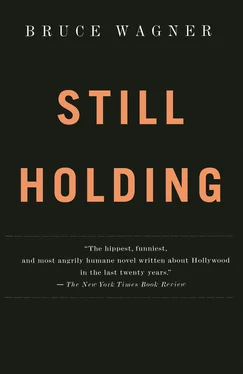• • •
THEY SAT face to face.
A camera taped them as they read.
Kit seemed shy, but maybe she was just projecting. It was difficult for her to be in the moment. She knew Mr. Reiner was looking for chemistry more than anything else; she was a long shot but didn’t care, because as far as Becca was concerned, she’d already won. If I have to pack my bags and go home tomorrow, she thought, by God’s grace it would be all right. Here she was, all the way from Waynesboro, Virginia, where she’d slaved in a store just like the one Jennifer Aniston did in The Good Girl. She thought of how hard it had been for others before her — especially Drew, who, at thirteen, spent a year in lockdown. Her own mother had put her there yet she still had JAID tattooed on her back, with angels. Every night from the hospital, Drew looked up at the moon and cried her heart out to her dead Grandpa John.
Here she was, after all the hard, hard times. She’d finagled her way onto a classy cable show and even been some kind of cult figure on the Web, and now she was in a room with Rob Reiner and Kit Lightfoot, cohorts and fellow artist-travelers…
No regrets!
• • •
OUTSIDE THE Coffee Bean, two teenage girls breezed by. One of them made a little gasp, then excitedly turned to her friend. A familiar reflex foretold the actress had again been mistaken for Drew.
But the whispering girl said, “That’s Becca Mondrain.”
Graduation
LISANNE SIGNED UP for a Fearless Fliers clinic at LAX. The woman said there would be around twenty-five in the group. Enrollment in classes for “aviophobics” had diminished in the months following 9/11 but over time had rebounded to previous levels. In fact, the woman said sunnily, because of the war in Iraq people were confronting their fears with newfound confidence.
The three-weekend course began with an informal overview. The counselor, a retired airline pilot, said the most important thing the group would learn was that their phobia emanated not from the fear of death but from the fear of losing control. They couldn’t really grasp the distinction, but he reassured them they had come to the right place. Everyone seemed to exhale at once when he quoted a statistical study from MIT that said if you took a commercial flight every day for the next 29,000 years, the odds were you’d be involved in just one crash.
The enrollees formed a circle and introduced themselves. They gave their names and occupations before delivering what Lisanne imagined to be AA-style confessionals of how each had found his or her way to Fearless Fliers. One woman, a pediatrician, said that years ago on a stormy night in Minnesota she’d boarded with a syringe of Demerol and given herself a shot in the ass, only to awaken hours later to find they were still on the runway. (Lisanne thought that was someone who probably should be in AA.) Everyone had their own special niche, like the generic panic freaks, for whom fear of flying was a midsize subsidiary of a much larger corporation — or the seasoned claustrophobes, who equated entering a plane with being sealed into a coffin. Lisanne enjoyed the eccentrics the most: the ones who thought that the plane would run out of gas or that God might snatch whichever aircraft happened past Him at whatever arbitrary moment in time. (God was superpremenstrual.) Some in the circle worried about pilots having psychotic breaks or passengers having psychotic breaks or air traffic controllers having psychotic breaks or terrorist passengers simply being themselves. One or two self-proclaimed divas admitted to having been escorted from flights due to pretakeoff “arias”—groans, moans, and high-pitched wails that erupted from seemingly bottomless depths as runways were taxied toward. A man in his sixties was possessed by wind shear and “sudden rollover,” a phrase he invoked and muttered, both prayer and imprecation, with near-comic insistency. (The common denominator of horror being turbulence, hands down.) A sardonic librarian said that whenever she booked a flight, she couldn’t help imagining an AP wire photo of some Middle American farmer’s field strewn with the debris of metal and body parts, being picked over by an FAA crash team. Torsos in tree branches and whatnot. Everyone laughed when the same woman — Lisanne thought she was funny enough to do stand-up — said she’d even attended multiple showings of a theater piece at UCLA that was basically actors re-creating dialogue from black box transcripts of fatal air crashes. Lisanne could relate, though it’d been a while since she’d lulled herself to sleep with the dog-eared paperback. She didn’t share that with the group. Still, when it came her turn, Lisanne found herself saying aloud what she’d never told anyone, let alone strangers — that because of her phobia, she took a train to her father’s deathbed, and missed his passing. Her story opened a floodgate; astonishingly, she wasn’t the only one. The classmates became emboldened. Together, they stared into the face of cowardice and did not like what they saw.
They were encouraged to write essays on worst-case fantasy flying scenarios and were shown how to “stack positive imagery,” slowly replacing bad thoughts and images with good ones. The counselors guided the class through breathing meditations — Lisanne was glad to be reminded of something so familiar. She had done a lot of “sits” at the hospice, but it was well over a year since she’d meditated on her own, as she used to.
On the last weekend, everyone trooped into a hangar and boarded a 727. They talked to pilots and stewards, mechanics, air traffic controllers, and engineers. They revolved through the cockpit for comprehensive demonstrations and Q & A. They sat in coach seats (seat belts on) while the counselors played a tape reproducing all the sounds one might hear in the course of a normal flight. The tape was constantly stopped and started, each sound discussed and overexplained.
• • •
THE GRADUATION FLIGHT to San Francisco was optional, but nearly everyone signed up. The airline gave them a special rate.
At the suggestion of the counselors, some Fearless Fliers wore rubber bands around their wrists to snap away negative thoughts and feelings. The librarian offered Lisanne herbs and essential oils that she picked up at a health food store. The blue “Fear of Flying” package read, “This box contains enough remedies for one flight.”
All of them sat together. Lisanne took her place by the window — hardly anyone wanted a window seat, and besides, she didn’t need to be bothered by the bathroom comings and goings of someone in the midst of a preflight freak-out — and quickly got into meditative posture. She focused on her nostrils, following the breath as it filled up her lungs. Sounds of the cabin — the bustle and stowing of bags by unneurotic passengers not in their group, the little suck-rush of air through vents, the buckling and unbuckling, the coughs, sneezes, and throat clearings, the sporadic groaning gallows humor of fellow graduates along with the soothing running commentary of Fearless Fliers counselors — floated in and out of her awareness. (She wondered if anyone had cheated and taken a tranquilizer.) Whenever a bad thought intruded, say, the jackscrewed Alaska Airlines Flight 261 plunging into the Pacific — they would soon be flying over the very place it had gone down — or the documentary she’d watched a few months ago on the Discovery Channel about the famous golfer and his buddies who died on a Lear — the plane broke contact and inexplicably drifted off course, fighter jets were scrambled and got right up close to see the windows frosted over, meaning the cabin had lost pressurization — or the time she had a drink with a temp Reggie hired and the gal said she was supposed to have been on the PSA flight to San Francisco that crashed because a vengeful employee went berserk. The temp said that at that time of her life she was commuting a lot and always took that particular morning flight and this one time she was late: she remembered being at the gate begging them to let her on but they said the flight was already closed. That reminded Lisanne of the English movie she saw when she was a girl, about the supernatural. A woman in a hospital kept dreaming that each night she awakened to ride the elevator down to the morgue, where a man stood and said, “Room for one more.” When the woman was finally discharged, she was about to board an airplane, and the attendant at the gate said the same thing—“Room for one more”—and because she’d had the premonition, the woman didn’t board and of course the plane crashed. Whenever Lisanne was jolted by a morbid train of thought, she used one of the relaxation techniques the counselors had walked them through. She was able to get back in touch with the core of her zazen practice and found that its reawakening served her well.
Читать дальше












